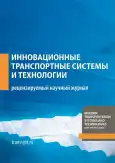Повышение устойчивости на основе выбора стратегии восстановления транспортных сетей при реализации опасных природных процессов
- Авторы: Ахтямов Р.Г.1
-
Учреждения:
- Петербургский государственный университет путей сообщения Императора Александра I
- Выпуск: Том 10, № 3 (2024)
- Страницы: 287-299
- Раздел: Обзоры
- URL: https://journals.rcsi.science/transj/article/view/265898
- DOI: https://doi.org/10.17816/transsyst633466
- ID: 265898
Цитировать
Полный текст
Аннотация
Цель. Разработка подхода по повышению устойчивости на основе выбора стратегии восстановления транспортных сетей при реализации опасных природных процессов.
Методы. На основе оценки динамики опасных природных процессов, в том числе, на примере экзогенных геологических процессов, которые могут послужить причиной нарушении в функционировании транспортной сети, а также структуры оценки устойчивости и восстановления транспортных сетей в условиях реализации факторов климатического риска сформулированы стратегии восстановления транспортной сети.
Результаты. На основе сформулированных стратегий возможно сетевое моделирование топологии транспортной сети. Для моделирования транспортная сеть может быть представлена в виде неориентированного взвешенного графа с набором узлов и ребер. Предложенная модель позволяет определить наиболее эффективную стратегию с точки зрения быстрого восстановления связности транспортной сети, на основе определения последовательности восстановления участков дорог с учетом времени восстановления. Ожидается, что эффективность процесса восстановления поврежденных участков транспортной сети будет меняться в зависимости от доли восстановленной сети, снижаясь при увеличении доли. В этой связи целесообразно оценить ту долю восстановления транспортной сети, которая будет необходима для выполнения задач формирований РСЧС в условиях проведения аварийно-спасательных и других неотложных работ на конкретной территории.
Заключение. Анализ и оценка альтернативных решений восстановления устойчивости транспортных сетей основывается на комплексности решаемых задач при реализации факторов климатического риска, таких как опасные природные процессы. В ряде случаев, для решения задач РСЧС не требуется полное восстановление транспортной сети, в отличие от задач, решаемых транспортной отраслью. Задача данной работы заключалась в разработке основы для оценки стратегий восстановления транспортных сетей, с выявлением особенностей каждой из рассмотренных стратегий в условиях неопределенности, а также повышение эксплуатационной устойчивости. Предложенный подход характеризуется гибкостью, что позволяет лицам, принимающим решения, оценить различные приоритеты, возникающие при развитии конкретной природной чрезвычайной ситуации на определенной территории (например, среднее время восстановления, эффективность процесса восстановления, величина неопределенности) при выборе наиболее желательной стратегии. Предполагается, что среднее время восстановления не имеет существенного различия между стратегиями, при полном восстановлении транспортной сети. Однако, при частичном восстановлении сети, необходимой для решения задач РСЧС, среднее время восстановления зависит от выбранной стратегии.
Ключевые слова
Полный текст
Открыть статью на сайте журналаОб авторах
Расул Гумерович Ахтямов
Петербургский государственный университет путей сообщения Императора Александра I
Автор, ответственный за переписку.
Email: ahtamov_zchs@mail.ru
ORCID iD: 0000-0001-8732-219X
SPIN-код: 2812-3782
кандидат технических наук, доцент
Россия, Санкт-ПетербургСписок литературы
- Tuzun AD, Ozdamar L. A mathematical model for post-disaster road restoration: enabling accessibility and evacuation. Transp. Res. Part E: Logist. Transp. Rev. 2014;61:56–67. doi: 10.1016/j.tre.2013.10.009
- Çelik M, Ergun Ö, Keskinocak P. The post-disaster debris clearance problem under incomplete information. Oper. Res. 2015;63:65–85. doi: 10.1287/opre.2014.1342
- Schintler LA, Kulkarni R, Gorman S, Stough R. Using raster-based GIS and graph theory to analyze complex networks. Netw. Spat. Econ. 2007;7:301–313. doi: 10.1007/s11067-007-9029-4
- Aydin NY, Duzgun HS, Wenzel F, Heinimann HR. Integration of stress testing with graph theory to assess the resilience of urban road networks under seismic hazards. Nat. Hazards. 2018;91:37–68. doi: 10.1007/s11069-017-3112z
- Shangyao Y, Chu JC, Yu-Lin S. Optimal scheduling for highway emergency repairs under large-scale supply-demand perturbations. IEEE Trans. Intell. Transp. Syst. 2014;15:2378–2393. doi: 10.1109/TITS.2014.2313628
- Yan S, Lin CK, Chen SY. Optimal scheduling of logistical support for an emergency roadway repair work schedule. Eng. Optim. 2012;44:1035–1055. doi: 10.1080/0305215X.2011.628389
- CRED/UNDRR. The Human Cost of Natural Disasters 2015: A Global Perspective; Centre for Research on the Epidemiology of Disaster (CRED): Brussels, Belgium. 2015:255. doi: 10.1016/b978-0-12-817465-4.00015-7
- IPCC, 2021: Summary for Policymakers. In: Climate Change 2021: The Physical Science Basis. Contribution of Working Group I to the Sixth Assessment Report of the Intergovernmental Panel on Climate Change. Cambridge: Cambridge University Press,. 2021:3–32. doi: 10.1017/9781009157896.001
- Akhtyamov RG, Mescheriakova NA. Assessment of the contribution and measures to reduce the impact of the railway industry on the development of global warming. E3S Web of Conferences. TT21C-2023. 2023:01001. doi: 10.1051/e3sconf/202338301001
- Aydin NY, Duzgun H, Heinimann HR, Wenzel F. Framework for improving the resilience and recovery of transportation networks under geohazard risks. International Journal of Disaster Risk Reduction. 2018;31:832–843. doi: 10.1016/j.ijdrr.2018.07.022
- Maya DP, Sörensen K. A GRASP metaheuristic to improve accessibility after a disaster. R Spectr. 2011;33:525–542. doi: 10.1007/s00291-011-0247-2
- Chang SE. Transportation planning for disasters: an accessibility approach. Environ. Plan. 2003;35:1051–1072. doi: 10.1068/a35195
- Titova TS, Akhtyamov RG, Mescheriakova NA. Ways to improve climate change adaptation plan of the transport. Modern Transportation Systems and Technologies. 2023;9:5–18. doi: 10.17816/transsyst2023925-18
- Yang S, Hu F, Thompson RG, et al. Criticality ranking for components of a transportation network at risk from tropical cyclones. Int. J. Disaster Risk Reduct. 2018;28:43–55. doi: 10.1016/j.ijdrr.2018.02.017
- Nelson JR, Grubesic TH. A repeated sampling method for oil spill impact uncertainty and interpolation. Int. J. Disaster Risk Reduct. 2017;22:420–430. doi: 10.1016/j.ijdrr.2017.01.014
- D’Lima M, Medda F. A new measure of resilience: an application to the London underground. Transp. Res. Part A: Policy Pract. 2015;81:35–46. doi: 10.1016/j.tra.2015.05.017
- Padgett JE, Barbosa AR, Chen S, Cox D. Multiple-Hazard fragility and restoration models of highway bridges for regional risk and resilience assessment in the United States: state-of-the-art review. J. Struct. Eng. 2017;143:04016188. doi: 10.1061/(ASCE)ST.1943-541X.0001672
- Baroud H, Ramirez-Marquez JE, Barker K, Rocco CM. Stochastic measures of network resilience: applications to waterway commodity flows. Risk Anal. 2014;34:1317–1335. doi: 10.1111/risa.12175
Дополнительные файлы









